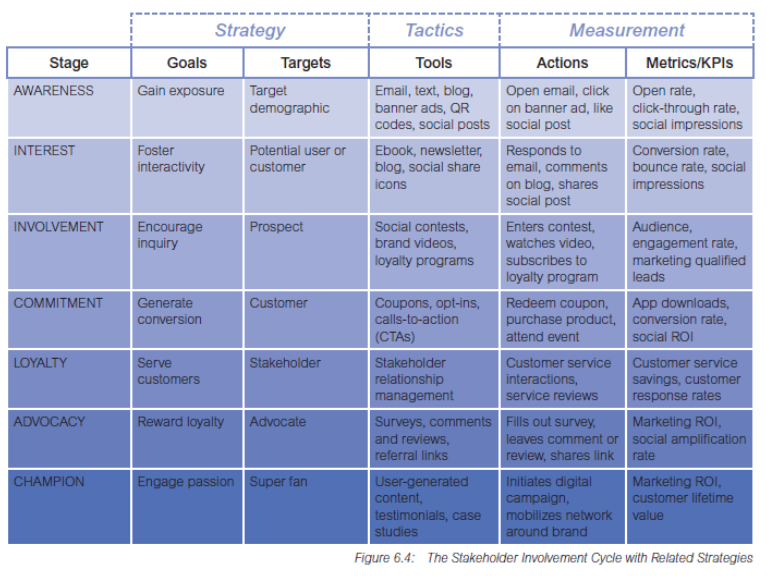The Stakeholder Involvement Cycle is a powerful tool for relating each stage of the stakeholder experience (SX) to the correspondent strategies, tactics, and tools that make up the IDM Strategic Model (see Figure 6.4 below).
Define & Establish
To better understand this relationship, we’ll use the example of our fictional business, Broad Learning Solutions (BLS), a 30-year-old, $50 million language training company in Fairfax, Virginia. BLS markets language learning resources through traditional educational wholesale distributors. To reposition itself for the digital age, the company recently purchased a state-of-the-art, cloud-based language training mobile application. In the past, BLS has been a heavily sales-focused organization; as such, its employees do not have the expertise or wherewithal to develop or launch a comprehensive digital marketing campaign.

In accordance with the initial “Define & Establish” (Chapter 7 of Digital Marketing: Integrating Strategy, Sustainability, and Purpose) component of the IDM Strategic Model, Samir, the BLS CMO, needs to define his goals. His team decides their first goal is to gain exposure for his new mobile app.
Focusing on the initial Awareness stage of the Stakeholder Involvement Cycle, his team’s research suggests they need to target college language students and professors as well as private language institutes with their newly crafted brand message.
Convey & Augment
Next, the team considers the possible tools (e.g., content marketing, social media marketing, SEO, paid search) they can employ to “Convey and Augment” their brand message to their target demographic during the Awareness stage. After factoring in time and budget considerations, the team decides to create unique written and video content and then implement a three-stage lead-generation email campaign. The initial email includes a video that introduces the target audience to BLS’ language learning app. The team will measure the effectiveness of the tactic by monitoring the open rates of the email and the click-through rates of the video.
To shepherd the audience to stage two of the SIC, Interest, the second email includes a link to a new eBook for free download that provides more detail about the features and benefits of the app. The eBook and corresponding landing page include embedded social share buttons to encourage social sharing. The main goal of stage two and the second email is to foster interactivity with the brand and its target audience by encouraging potential users of the mobile app to engage with BLS on social media (Facebook, Instagram, Twitter, etc.) and to share information about the new app with their followers.
As the potential users evolve into bona fide prospects, the goal is to encourage active inquiry into the properties of the mobile app as they enter the third stage of the SIC, Involvement. To accomplish this, BLS rolls out a 3rd and final email offering additional content about the app, including links to a recent blog (to drive prospects to the BLS website), as well as to a humorous YouTube video with testimonials of satisfied early adopters of the app. The BLS team measures visits to the blog and engagement with the video.
Connect & Convert
In the fourth, Commitment, stage of the SIC, the mobile app prospect is “called to action” utilizing various tactics and tools covered in the “Connect and Convert” phase of the IDM Strategic Model; these include opt-in offers such as a newsletter subscription, a coupon for purchasing the app and a loyalty program opt-in. All actions, from coupon redemption to purchase to loyalty program registration, are tracked to determine customer acquisition rate.
Measure & Refine
At this point, the stakeholder moves into the post-commitment, or Loyalty, stage of the SIC. In this stage, BLS’ primary goal is to serve the stakeholder’s needs and inquiries in a timely manner and to generate long-term brand loyalty; this process is primarily managed with SRM and SRM software. All service interactions and reviews provide data for tracking and evaluation per the “Measure and Refine” component of the IDM Strategic Model.
As the BLS team targets stages six and seven of the SIC, Advocacy and Championing, their focus is on rewarding loyal stakeholders and engaging these stakeholders’ passion for the mobile app. Brand advocates are encouraged to actively share their experiences through online reviews and engage others through social media, while the most passionate super fans will generate their own initiatives to promote the BLS mobile app throughout their networks and the language learning social community.
The Bottom Line
The incorporation of the Stakeholder Involvement Cycle and customer experience with the strategies, tactics, and tools of the IDM Strategic Model provides a powerful, integrated approach to an organization’s digital marketing efforts.
Questions
- How does integrating Purpose into the SIC amplify the engagement at each stage?
- Suggest three examples of the impact of sustainability on an individual stakeholder’s decision-making. As a marketer, how will these influence campaign decisions at each stage of the SIC?
